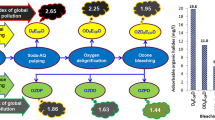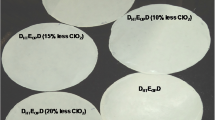Abstract
This study compared the chlorophenolic compounds generated during the bleaching of wheat straw pulp. The six different bleaching sequences used in present study were: (i) chlorine-extraction-hypo (CEH); (ii) persulphate-peroxide-chlorine-extraction-hypo (Px-P-CEH); (iii) oxygen-chlorine-extraction-hypo (OCEH); (iv) chlorine dioxide-extraction-chlorine dioxide (DED); (v) persulphate-peroxide-chlorine dioxide-extraction-chlorine dioxide (Px-P-DED); and (vi) oxygen-chlorine dioxide-extraction-chlorine dioxide (ODED) bleaching. The concentrations of a large number of identified chlorophenolic compounds often exceed their threshold concentrations in CEH effluent. Therefore, the untreated effluent generated from the CEH bleaching sequence of wheat straw pulp can be considered toxic. Prebleaching (PxP) reduces the generation of chlorophenolic compounds by 36 % in the (PxP)CEH sequence. Oxygen prebleaching reduces the generation of chlorophenolic compounds by 86 % in the OCEH bleaching effluent. The PxP also reduces the generation of chlorophenolic compounds by 46 % in the (PxP)DED bleaching sequence and oxygen delignification substantially reduces the generation of the compounds by 78 %.









Similar content being viewed by others
References
Antongiovanni M, Sargentini C (1991) Variability in chemical composition of straws. Options Médit Sér Sémin 16:49–53
Axegård P (1986) Substituting chlorine dioxide for elemental chlorine makes bleach plant effluent less toxic. TAPPI J 69(10):54–59
Axegård P, Renberg L (1998) The minimal impact of bleached kraft mill effluent. Pulp Pap Can J 99(4):85–90
Axegård P, Dahlman O, Haglind I, Jacobson B, Morck R, Strömberg L (1993) Pulp bleaching and environment—the situation. Nord Pulp Pap Res J 4:365
Berry RM, Luthe CE, Voss RH, Wrist PE, Axegard P, Gellerstedt G, Lindblad PO, Pöpke IJ (1991) The effects of recent changes in bleached softwood kraft mill technology on organochlorine emissions: an international perspective. Pulp Pap Can J 92(6):155–165
Bright D, Hodson P, Lehtinen KJ, McKague AB, Rodgers J, Solomon K (1993) Evaluation of ecological risks associated with the use of chlorine dioxide for the bleaching of pulp—scientific progress since. Report prepared for Alliance for Environmental Technology
Davis JC, Hoos RAW (1975) Use of sodium pentachlorophenate and dehydroabietic acid as reference toxicants for salmonid bioassays. J Fish Res Board Can 32:411–416
Earl PF, Reeve DW (1989) Chlorinated organic matter in bleached chemical pulp production—the effect of chlorination stage variables on chlorinated organic matter in effluent. TAPPI J 72(10):183–188
EC (2001) EC Decision 2455/2001/ED of European Parliament and the Council of Nov. 20, establishing the list of priority substances in the field of water policy and amending directive 2000/60 EC (L331 of 15-12-2002)
Folke J (1985) Organics in wheat and rye straw pulp bleaching and combined mill effluents (I) chemical characterization and bio-degradation studies. Toxicol Environ Chem 10:1–24
Freire CSR, Silvestre AJD, Pascoal NC (2003) Carbohydrate derived chlorinated compounds in ECF bleaching of hardwood pulps: formation, degradation & contribution to AOX in a bleached kraft pulp mill. J Environ Sci Technol 37(4):811–814
Hayward K (1998) Drinking water contaminant hit list for US EPA. Water 21, Sept–Oct, 4
Hedjazi S, Kordsachia O, Rudolf P, Latibarid AJ, Tschirnere U (2009) Alkaline sulfite–anthraquinone (AS/AQ) pulping of wheat straw and totally chlorine free (TCF) bleaching of pulps. Ind Crops Prod 29:27–36
Huang G, Shi JX, Langrish TAG (2007) A new pulping process for wheat straw to reduce problems with the discharge of black liquor. Bioresour Technol 98:2829–2835
Jimenez L, Rodrıguez A, Perez A, Moral A, Serrano L (2008) Alternative raw materials and pulping process using clean technologies. Ind Crops Prod 28:11–16
Kahm L, Le Bigot Y, Delmas M, Avignon G (2005) Delignification of wheat straw using a mixture of carboxylic acids and peroxoacids. Ind Crops Prod 21:9–15
Keith LH, Telliard WA (1979) Priority pollutants: a prospective view. Enviorn Sci Technol J 13(4):416–424
Leach JM, Chung LTK (1978) Development of a chemical toxicity assay for pulp mill effluents. Grant No. R804977010. EPA, Cincinnati, OH
Liebergott N, Van Lierop B, Nolin A, Faubert M, Laflamme J (1991) Modifying the bleaching process to decrease AOX formation. Pulp Pap Can J 92(3):84–89
Lindstrom K, Nordin J (1976) Gas chromatography mass spectrometry of chlorophenols in spent bleach liquors. J Chromatogr 128:13–26
Mathur S, Kumar S, Rao NJ (2001) Application of commercial xylanases in bleaching—a review. IPPTA J 13(1):13–24
Mattson K, Lehtinen K-J, Tana J, Harding J, Kukkonen J, Nakari T, Engström C (2001) Effects of pulp mill effluents and restricted die on growth and physiology of rainbow trout (Oncorhynchus mykins). Ecotoxicol Environ Saf J 49:144–154
McKague AB, Chew W, Zhu S, Reeve DW (1998) Proceedings of the International Pulp Bleaching Conference, Helsinki, Finland 1, pp 205–212
Mocarelli P, Brambilla P, Gerthoux PM, Patterson DG Jr, Needham LL (1996) Changes in sex ratio with exposure to dioxin. Lancet 348:409
NORAD-COURSE (1993) Laboratory manual for pulp and paper laboratory. The Norwegian Institute of Technology, Department of Chemical Engineering, University of Trondheim, Trondheim
Okumura R, Yamashita Y, Kohno Y, Nagasaka H (2004) Historical trends of PCDD/Fs and Co-PCBs in a sediment core collected in Sendai Bay. Jpn Water Res J 38(16):3511–3522
Panwar S, Gupta MK, Mishra S (2002) Environmental impact of toxic chlorinated phenolics released in pulp and paper industry and its control measures. In: Interaction meet on environmental impact of toxic substances released in pulp & paper industry, Proceedings, pp 69–73
Ray AK, Kumar V, Dutt D, Mittal KC, Upadhyaya JS (2005) Comparison of ECF bleaching sequences of bagasse pulp. In: IPPTA convention, pp 77–82
Roncero MB, Torres AL, Colom JF, Vidal T (2003a) TCF bleaching of wheat straw pulp using ozone and xylanase. Part A: paper quality assessment. Bioresour Technol 87:305–314
Roncero MB, Torres AL, Colom JF, Vidal T (2003b) TCF bleaching of wheat straw pulp using ozone and xylanase. Part B: kinetic studies. Bioresour Technol 87:315–323
Servizi JA, Gordon RW, Martens DW (1968) Toxicity of two chlorinated catechols, possible components of kraft pulp mill bleach waste. International Pacific Salmon Fisheries Commission progress report no 17
Sharma C, Mohanty S, Kumar S, Rao NJ (1996a) Gas chromatographic analysis of chlorophenolic, resin and fatty acids in chlorination and caustic extraction effluent from Kahi-grass. Analyst 121:1963–1967
Sharma C, Mohanty S, Kumar S, Rao NJ (1996b) Gas chromatographic analysis of chlorophenolic, resin and fatty acids in effluents from bleaching processes of agricultural residues. Int J Environ Anal Chem 64:289–300
Sharma C, Mohanty S, Kumar S, Rao NJ (1997) Gas chromatographic determination of pollutants in the chlorination and caustic extraction stage effluent from the bleaching of a bamboo pulp. Talanta 44(10):1911–1918
Singh RP (1979) Bleaching of pulp, 3rd edn. TAPPI Press, Atlanta, pp 29–89
Singh S, Dutt D, Tyagi CH, Upadhyaya JS (2011) Bio-conventional bleaching of wheat straw soda-AQ pulp with crude xylanases from SH-1 NTCC-1163 and SH-2 NTCC-1164 strains of Coprinellus disseminatus to mitigate AOX generation. N Biotechnol 28(1):47–57
Svenningsen NW (2001) Network for industrial environmental management—a new approach to old challenges in the Asia-Pacific pulp and paper industry. Paperex India, pp 50–51
Takeuchi K, Suwa Y, Yamagishi T, Yonezawa Y (2000) Anaerobic transformation of chlorophenols in methanogenic sludge unexposed to chlorophenols. Chemosphere 41:1457–1462
TAPPI (1992) Test methods, T-236 cm-85. Kappa number of pulp. TAPPI Press, Atlanta, Georgia, pp 1–3
TAPPI (2000–2001) Test methods, standards methods for pulp & paper. TAPPI Press, Atlanta
Tatum VL, Fisher RP (1995) The endocrine active chemical issue. In: Proceedings of the 1995 international environmental conference. TAPPI Press, Atlanta, pp 365–368
Tremblay L, Van Der Kraak G (1999) Comparison between the effects of phytoserol β-sitosterol and pulp and paper mill effluents on sexually immature rainbow trout. Environ Toxicol Chem J 18:329–336
Voss RH, Wearing JT, Mortimer RD, Kovacs T, Wong A (1980) Chlorinated organics in kraft bleachery effluents. Paperi ja Puu 62(12):809–814
Voss RH, Wong A, Wearing JT (1981) Effect of softwood chlorination on the formation of toxic chlorinated compounds. Pulp Pap Can J 82(2):97–105
Xie T-M, Lu Z-J (1987) A preliminary study of chlorophenolics in non-wood pulp bleaching effluents. Nordic Pulp Pap Res J 2:56–60
Zhang H, He Z, Yonghao N (2011) Improvement of high-yield pulp properties by using a small amount of bleached wheat straw pulp. Bioresour Technol 102:2829–2833
Author information
Authors and Affiliations
Corresponding author
Rights and permissions
About this article
Cite this article
Malhotra, R., Prakash, D., Shukla, S.K. et al. Comparative study of toxic chlorophenolic compounds generated in various bleaching sequences of wheat straw pulp. Clean Techn Environ Policy 15, 999–1011 (2013). https://doi.org/10.1007/s10098-013-0578-6
Received:
Accepted:
Published:
Issue Date:
DOI: https://doi.org/10.1007/s10098-013-0578-6




